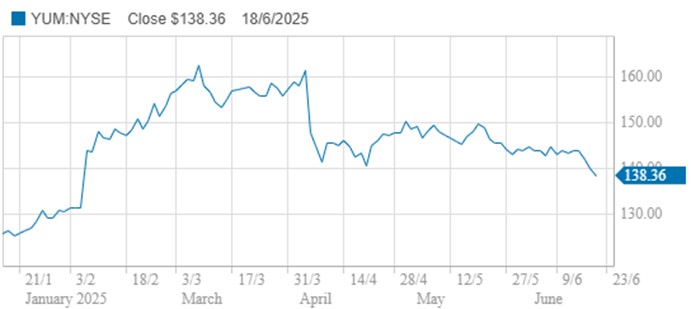Stock in Focus: Yum! Brands (YUM)
 CommSec
CommSec
15 July 2025
Is now the right time to dig in to Yum!’s famous fast-food labels?
There are only so many companies in the world listed on the New York Stock Exchange excited enough to have an exclamation point in their name. Yum! Brands is one of them!
You may not have heard of Yum! Brands, Inc. (NYSE: YUM), but you’ll have definitely heard of at least one of its four subsidiaries: Kentucky Fried Chicken (KFC), Taco Bell, Pizza Hut and Habit Burger & Grill. Combined there are around 61,000 of these restaurants in over 155 countries and territories, generating more than US$65bn in sales1. The Louisville-headquartered firm is the second-largest global restaurant company, behind a certain set of golden arches, with an estimated market cap of US$39.17bn2.
Yum! Brands is the newest evolution of Tricon, formerly a division of PepsiCo, and generates the bulk of its revenue from franchise royalties and marketing contributions3. Yum! Brands also operates in China as trademark licensee Yum China (NYSE: YUMC), the largest restaurant operator in the country, which along with the “big three” includes other brands such as Little Sheep, Huang Ji Huang and Lavazza4.
New leadership
On 17 June 2025, Yum! Brands’ Chief Financial & Franchise Officer Chris Turner was named the company’s next CEO, effective 1 October5. The announcement was not enough to immediately halt or reverse the downward trajectory of the company’s share price, which on 7 March hit a record US$162.53, over Q4 FY25. The share price closed at US$138.36 on 18 June6.

Source: CommSec, as of 23/6/25.
While Morningstar predicts that “under Turner, we expect Yum! will continue to exploit Taco Bell’s strong growth opportunities in the US and internationally”, it also notes that “Yum! needs to improve results at KFC and Pizza Hut in the US as both have struggled to generate consistent sales growth against massive competition”7.
New concepts
In December 2024, KFC thought outside the (three-piece) box to open its inaugural “Saucy by KFC” concept store in Orlando, Florida. Designed to appeal to Gen Z, Saucy by KFC focuses on chicken tenders and dipping sauces, as well as offering new desserts, drinks and sides not found in its flagship brand’s restaurants8. The store’s dominant colour is pink rather than KFC’s familiar red9.
In the same month, further west in San Diego, California, Taco Bell opened its “Live Mas Café” prototype store, where beverages including milkshakes, coffees, iced and soft drinks take centre stage in place of tacos and burritos10.
Ongoing innovations such as these appear crucial to the continued success and growth of Yum! Brands’ famous subsidiaries. Morningstar notes that “Taco Bell has strong growth opportunities both in the US and internationally fuelled by product innovation… [and] Taco Bell’s ability to generate excitement through menu innovation and promotional items, mixing as high as 10%-20% of sales, has rendered it quite popular with the millennial and Gen Z audience”11.
New tech
Morningstar argues that while “the restaurant industry has changed a lot in recent years… we remain encouraged by the ability of the largest operators, including Yum! Brands, to accelerate critical investments in e-commerce platforms, delivery integration, and technological solutions that meet the evolving demands of the modern restaurant consumer”.
In February, Yum! Brands introduced Byte by Yum!, an AI-driven tech platform incorporating online and mobile app ordering, point of sale, kitchen and delivery optimisation, menu management, inventory and labour management, and team member tools, which the company claimed would “enable easy operations for team members and improved experiences for customers, while consolidating essential systems into a cohesive, easy-to-manage platform”12.
There are already more than 500 Taco Bell outlets across the US using AI technology to take drive-through orders. Morningstar suggests that, as with its product and restaurant innovations, “we're positive on Yum!'s ability to… continue to take market share as innovations like Byte, as well as its existing suite of technology tools, continue to improve franchisee economics.”
Looking ahead
As of 8 July 2025, the consensus for Yum! Brands’ stock price is “outperform”13.
On the bullish side, Morningstar argues “strong international partnerships and brand portability position Yum! well to take advantage of growing consumption classes in attractive markets like Indonesia, Thailand, and China”14. It also cautions, however, that “developing supply chain infrastructure, growing consumption classes, and an increase in viable franchise partners abroad could erode Yum!'s first-mover advantages as Western brands look to expand internationally”15.

